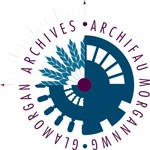The papers of J J Neale, co-owner of the Cardiff fish merchants, Neale and West, include an extensive collection of maritime images that date from the late 19th century. Alongside photographs of the Neale and West fishing fleet there are also several photographs of vessels that had little connection with Neale and West or Cardiff. It would appear they were selected and added to the collection because, in each case, they were considered to be ‘something special’.

Trawler LO77 under full sail (DX194/8/17)
On first inspection you might wonder why the photograph of a fishing smack was included in the collection given that, in the early 19th century, there were thousands of small fishing smacks based in ports around the coast of Britain. From the registration number on the sail, however, it is almost certain that the photograph is of the Ann Hewett. Built in Gravesend for the Hewett family, owners of the Short Blue fleet, at a cost of £1200, the Ann Hewett carried the LO77 registration mark for over 50 years.

Loading catch from trawler deck to rowing boat (DX194/8/14)
Launched in November 1836 the Ann Hewett joined a fleet that by the mid-19th century was the biggest fishing fleet in the world. The Short Blue fleet was based at Barking, the home port for over a hundred fishing smacks in the 1830s. It is hard to believe now but, at that time, fishing smacks sailed up the Thames, almost into the heart of London, and unloaded their catch at Barking for sale at the Billingsgate fish market.

Emptying the net (DX194/8/73)
The biggest problem facing the Short Blue fleet and its competitors was that, unless the fish were salted, boats had to return to Barking every few days so that the catch could be transported fresh to Billingsgate. The Ann Hewett was built to a design, probably developed by the Dutch in the 18th century, to address this problem. In many respects she resembled many other sailing smacks, being 60 foot in length, around 50 tons and with a crew of 8. However, she differed in one important aspect, in that she was built with a large well in the central section of the smack where fish could be kept alive until her return to port. Situated between the 2 masts and sealed from the rest of the boat by watertight compartments, the well was filled with sea water that entered through small holes drilled into the hull of the boat below the water line.
It was a design that, at the time, revolutionised deep sea fishing around the world. Known as ‘well smacks’, the new vessels were expensive to build and difficult to manoeuvre under sail. The costs, however, were more than offset, with the well allowing smacks to travel further out to sea and fish for several weeks before returning with fresh fish held in the well. Ironically, though, the Ann Hewett had to transfer her fish to hatch boats at Gravesend for transport to Billingsgate. Even in the first half of the 19th century, the Thames was polluted and allowing river water into the well would have ruined the fish.

Displaying a large skate (DX194/8/77)
Yet, even before the advent of the steam trawler, in the second half of the 19th century, the competitive edge of the well smack was being eroded. The development of ‘fleet fishing’, with large numbers of fishing smacks serviced by a constant shuttle of smaller boats taking the catch ashore, meant that the well was of less value. In addition, the use of ice, pioneered by the Short Blue fleet in England, provided other means of keeping the catch fresh while at sea.
Initially ice was imported, at some cost, from Norway, and stored for up to a year in deep thick walled ice houses built at the ports. Soon, however, supplies were secured from local farmers along the east coast of Britain who realised that money was to be made from flooding their land in the winter months and selling the ice to the fish merchants.
The Ann Hewett was sold after around twenty years’ service but continued to work as a fishing smack until the late 1880s. Our photograph was probably taken when she was under new ownership for there is no sign of the small square flag – the ‘short blue’ – flown at the mast head by the Short Blue fleet.
There are no records of the Ann Hewett visiting south Wales, but there was one connection. In March 1872 she was involved in a collision in the North Sea with the large Norwegian barque, Septentrio. One of her crew was lost overboard but picked up by the Septentrio. In heavy seas it was impossible to return to the Ann Hewett, so there was little option but for him to remain on board the barque. It just so happened that the Septentrio was carrying timber from Norway to Cardiff. It must have been a strange experience for a fisherman from the east coast of England, spending two weeks with a Norwegian crew and then being offloaded at the East Bute Dock when the Septentrio arrived in Cardiff on 2 April 1872. Let’s hope that Cardiff gave him a warm welcome before he set off on the long journey back to the east coast and the Ann Hewett.
The photograph of the Ann Hewett is one of a collection held with the papers of J J Neale at Glamorgan Archives under reference DX194. It can be accessed on line at http://calmview.cardiff.gov.uk/.
Tony Peters, Glamorgan Archives Volunteer








